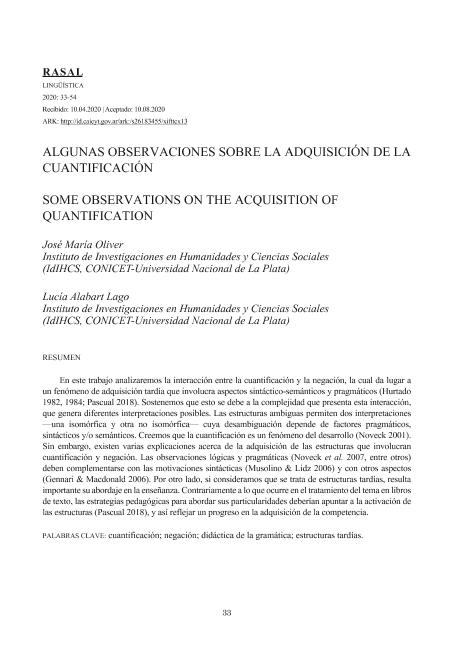Artículo
En este trabajo analizaremos la interacción entre la cuantificación y la negación, la cual da lugar a un fenómeno de adquisición tardía que involucra aspectos sintáctico-semánticos y pragmáticos (Hurtado 1982, 1984; Pascual 2018). Sostenemos que esto se debe a la complejidad que presenta esta interacción, que genera diferentes interpretaciones posibles. Las estructuras ambiguas permiten dos interpretaciones ?una isomórfica y otra no isomórfica? cuya desambiguación depende de factores pragmáticos, sintácticos y/o semánticos. Creemos que la cuantificación es un fenómeno del desarrollo (Noveck 2001). Sin embargo, existen varias explicaciones acerca de la adquisición de las estructuras que involucran cuantificación y negación. Las observaciones lógicas y pragmáticas (Noveck et al. 2007, entre otros) deben complementarse con las motivaciones sintácticas (Musolino & Lidz 2006) y con otros aspectos (Gennari & Macdonald 2006). Por otro lado, si consideramos que se trata de estructuras tardías, resulta importante su abordaje en la enseñanza. Contrariamente a lo que ocurre en el tratamiento del tema en libros de texto, las estrategias pedagógicas para abordar sus particularidades deberían apuntar a la activación de las estructuras (Pascual 2018), y así reflejar un progreso en la adquisición de la competencia. In this work we will analyze the interaction between quantification and negation, which gives rise to a late-acquired phenomenon that involves syntactic-semantic and pragmatic aspects (Hurtado 1982, 1984; Pascual 2018). We argue that this is due to the complexity of the interaction, which allows for different possible interpretations. Ambiguous structures license two interpretations —one isomorphic and one non-isomorphic— the disambiguation of which depends on pragmatic, syntactic, and/or semantic factors. We believe that quantification is a developmental phenomenon (Noveck 2001). However, there are several explanations about the acquisition of the structures involving quantification and negation. Logical and pragmatic observations (Noveck et al. 2007, among others) must be complemented with syntactic motivations (Musolino & Lidz 2006) and with other aspects (Gennari & Macdonald 2006). On the other hand, if it is considered that these are late-acquired structures, the teaching approach is important. As opposed to what happens in the treatment of the topic in textbooks, we believe that the pedagogical strategies to address its particularities should aim at the activation of structures (Pascual 2018), and thus reflect progress in the acquisition of competence.
Algunas observaciones sobre la adquisición de la cuantificación
Título:
Some observations on the acquisition of quantification
Fecha de publicación:
30/08/2020
Editorial:
Sociedad Argentina de Estudios Lingüísticos
Revista:
RASAL Lingüística
ISSN:
2250-7353
e-ISSN:
2618-3455
Idioma:
Español
Tipo de recurso:
Artículo publicado
Clasificación temática:
Resumen
Palabras clave:
CUANTIFICACIÓN
,
NEGACIÓN
,
DIDÁCTICA DE LA GRAMÁTICA
,
ESTRUCTURAS TARDÍAS
Archivos asociados
Licencia
Identificadores
Colecciones
Articulos(IDIHCS)
Articulos de INST.DE INVEST.EN HUMANIDADES Y CS SOCIALES
Articulos de INST.DE INVEST.EN HUMANIDADES Y CS SOCIALES
Citación
Oliver, José María; Alabart Lago, Lucia; Algunas observaciones sobre la adquisición de la cuantificación; Sociedad Argentina de Estudios Lingüísticos; RASAL Lingüística; 2; 30-8-2020; 33-54
Compartir




